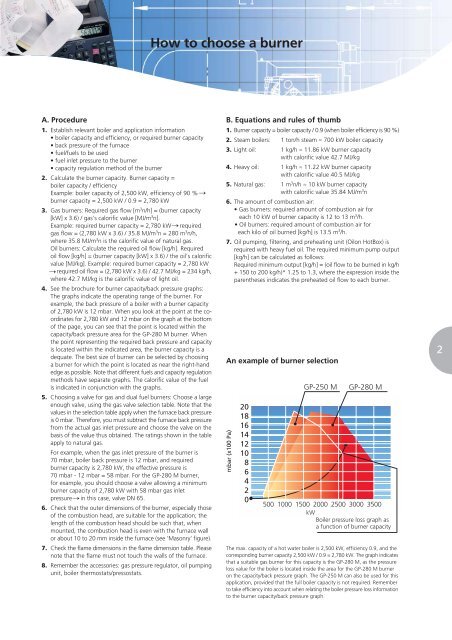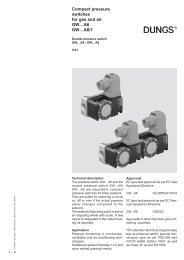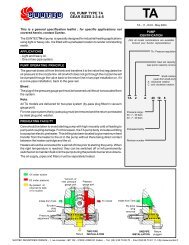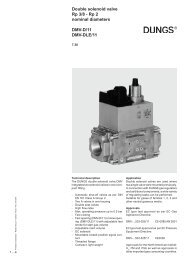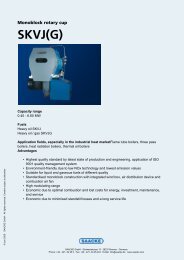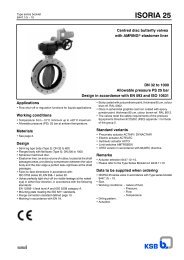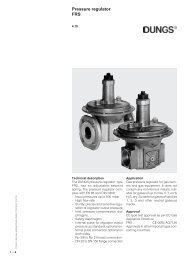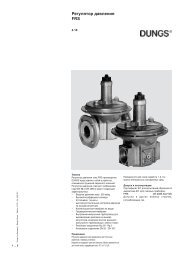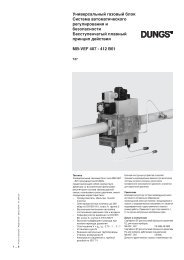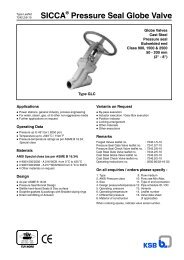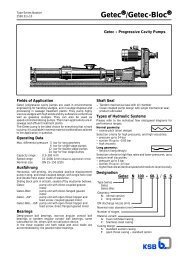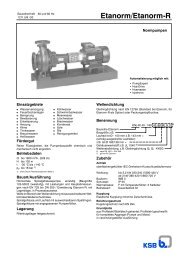Gas burners - Filter
Gas burners - Filter
Gas burners - Filter
You also want an ePaper? Increase the reach of your titles
YUMPU automatically turns print PDFs into web optimized ePapers that Google loves.
A. Procedure<br />
1. Establish relevant boiler and application information<br />
• boiler capacity and efficiency, or required burner capacity<br />
• back pressure of the furnace<br />
• fuel/fuels to be used<br />
• fuel inlet pressure to the burner<br />
• capacity regulation method of the burner<br />
2. Calculate the burner capacity. Burner capacity =<br />
boiler capacity / efficiency<br />
Example: boiler capacity of 2,500 kW, efficiency of 90 %<br />
burner capacity = 2,500 kW / 0.9 = 2,780 kW<br />
3. <strong>Gas</strong> <strong>burners</strong>: Required gas flow [m3n/h] = (burner capacity<br />
[kW] x 3.6) / gas’s calorific value [MJ/m3n]. Example: required burner capacity = 2,780 kW required<br />
gas flow = (2,780 kW x 3.6) / 35.8 MJ/m3n = 280 m3n/h, where 35.8 MJ/m3n is the calorific value of natural gas.<br />
Oil <strong>burners</strong>: Calculate the required oil flow [kg/h]. Required<br />
oil flow [kg/h] = (burner capacity [kW] x 3.6) / the oil’s calorific<br />
value [MJ/kg]. Example: required burner capacity = 2,780 kW<br />
required oil flow = (2,780 kW x 3.6) / 42.7 MJ/kg = 234 kg/h,<br />
where 42.7 MJ/kg is the calorific value of light oil.<br />
4. See the brochure for burner capacity/back pressure graphs:<br />
The graphs indicate the operating range of the burner. For<br />
example, the back pressure of a boiler with a burner capacity<br />
of 2,780 kW is 12 mbar. When you look at the point at the coordinates<br />
for 2,780 kW and 12 mbar on the graph at the bottom<br />
of the page, you can see that the point is located within the<br />
capacity/back pressure area for the GP-280 M burner. When<br />
the point representing the required back pressure and capacity<br />
is located within the indicated area, the burner capacity is a<br />
dequate. The best size of burner can be selected by choosing<br />
a burner for which the point is located as near the right-hand<br />
edge as possible. Note that different fuels and capacity regulation<br />
methods have separate graphs. The calorific value of the fuel<br />
is indicated in conjunction with the graphs.<br />
5. Choosing a valve for gas and dual fuel <strong>burners</strong>: Choose a large<br />
enough valve, using the gas valve selection table. Note that the<br />
values in the selection table apply when the furnace back pressure<br />
is 0 mbar. Therefore, you must subtract the furnace back pressure<br />
from the actual gas inlet pressure and choose the valve on the<br />
basis of the value thus obtained. The ratings shown in the table<br />
apply to natural gas.<br />
For example, when the gas inlet pressure of the burner is<br />
70 mbar, boiler back pressure is 12 mbar, and required<br />
burner capacity is 2,780 kW, the effective pressure is<br />
70 mbar - 12 mbar = 58 mbar. For the GP-280 M burner,<br />
for example, you should choose a valve allowing a minimum<br />
burner capacity of 2,780 kW with 58 mbar gas inlet<br />
pressure in this case, valve DN 65.<br />
6. Check that the outer dimensions of the burner, especially those<br />
of the combustion head, are suitable for the application; the<br />
length of the combustion head should be such that, when<br />
mounted, the combustion head is even with the furnace wall<br />
or about 10 to 20 mm inside the furnace (see ‘Masonry’ figure).<br />
7. Check the flame dimensions in the flame dimension table. Please<br />
note that the flame must not touch the walls of the furnace.<br />
8. Remember the accessories: gas pressure regulator, oil pumping<br />
unit, boiler thermostats/pressostats.<br />
How to choose a burner<br />
B. Equations and rules of thumb<br />
1. Burner capacity = boiler capacity / 0.9 (when boiler efficiency is 90 %)<br />
2. Steam boilers: 1 ton/h steam ≈ 700 kW boiler capacity<br />
3. Light oil: 1 kg/h ≈ 11.86 kW burner capacity<br />
with calorific value 42.7 MJ/kg<br />
4. Heavy oil: 1 kg/h ≈ 11.22 kW burner capacity<br />
with calorific value 40.5 MJ/kg<br />
5. Natural gas: 1 m3n/h ≈ 10 kW burner capacity<br />
with calorific value 35.84 MJ/m3n 6. The amount of combustion air:<br />
• <strong>Gas</strong> <strong>burners</strong>: required amount of combustion air for<br />
each 10 kW of burner capacity is 12 to 13 m3 /h.<br />
• Oil <strong>burners</strong>: required amount of combustion air for<br />
each kilo of oil burned [kg/h] is 13.5 m3 /h.<br />
7. Oil pumping, filtering, and preheating unit (Oilon HotBox) is<br />
required with heavy fuel oil. The required minimum pump output<br />
[kg/h] can be calculated as follows:<br />
Required minimum output [kg/h] = (oil flow to be burned in kg/h<br />
+ 150 to 200 kg/h)* 1.25 to 1.3, where the expression inside the<br />
parentheses indicates the preheated oil flow to each burner.<br />
An example of burner selection<br />
mbar (x100 Pa)<br />
20<br />
18<br />
16<br />
14<br />
12<br />
10<br />
8<br />
6<br />
4<br />
2<br />
0<br />
GP-250 M GP-280 M<br />
500 1000 1500 2000 2500 3000 3500<br />
kW<br />
Boiler pressure loss graph as<br />
a function of burner capacity<br />
The max. capacity of a hot water boiler is 2,500 kW, efficiency 0.9, and the<br />
corresponding burner capacity 2,500 kW / 0.9 = 2,780 kW. The graph indicates<br />
that a suitable gas burner for this capacity is the GP-280 M, as the pressure<br />
loss value for the boiler is located inside the area for the GP-280 M burner<br />
on the capacity/back pressure graph. The GP-250 M can also be used for this<br />
application, provided that the full boiler capacity is not required. Remember<br />
to take efficiency into account when relating the boiler pressure loss information<br />
to the burner capacity/back pressure graph.<br />
2


